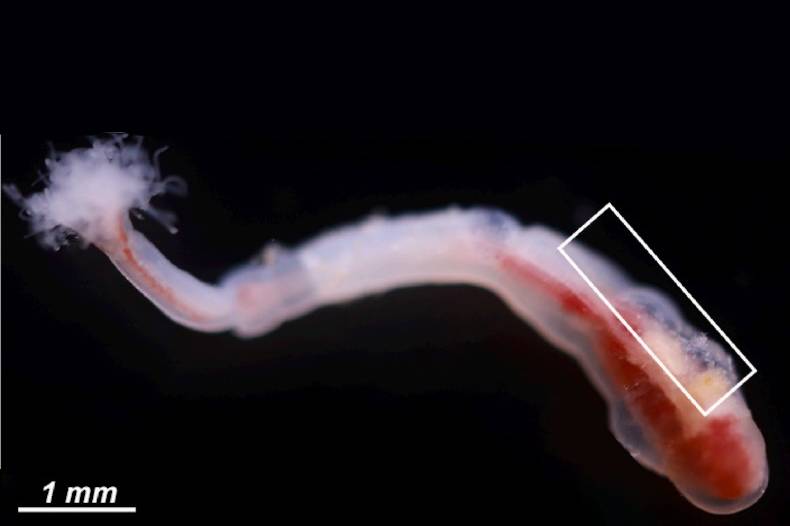Russian Scientists Have Studied Marine Worm with Unique Spermatozoa

Russian scientists at A.V. Zhirmunsky National Scientific Centre of Marine Biology, HSE University, and Moscow State University have studied Phoronis embryolabi, a rare species of marine invertebrate found in the waters of the Sea of Japan. This species is notable for its unique reproductive system, which includes the development of larvae within the parent’s body and an unusual sperm structure. The study's findings contribute to our understanding of the evolutionary adaptations of marine organisms to extreme conditions. The study has been published in Zoologischer Anzeiger.
Phoronis embryolabi is a small marine worm that is viviparous, meaning it gives birth to live young, with larvae developing inside the parent’s body. This is an important adaptation for Phoronis embryolabi, which lives as a commensal organism—a type of symbiotic relationship where the commensal benefits while the host remains unaffected—in the holes of burrowing shrimp. It has been discovered that the reproductive process in this species involves the formation of spermatozoa with an unusual structure.
Spermatozoa are filamentous cells capable of moving within the confined spaces of the body. They develop in vasoperitoneal tissue (VPT) that surrounds blood vessels. 'This structure enables spermatozoa to move efficiently through narrow spaces filled with cells and embryos,' according to Elena Temereva, Professor of the Joint Department with RAS Shemyakin-Ovchinnikov Institute of Bioorganic Chemistry, HSE Faculty of Biology and Biotechnology.
Unlike other phoronid species, whose spermatozoa are V-shaped, Phoronis embryolabi’s spermatozoa maintain an elongated shape throughout all stages of maturity. The flagellum, essential for movement, is closely aligned with the cell body, which aids in movement through the narrow spaces of the body cavity. This is important, because the numerous embryos and other cells developing inside the body create additional challenges for sperm movement.
Sperm cells in Phoronis embryolabi, known as introsperm, possess unique adaptations typical of species with internal fertilisation. To reach the eggs, they must navigate through dense layers of cells and squeeze in the narrow spaces within the body. The researchers found that these spermatozoa are equipped with a collar around the base of the flagellum, which, along with undulating movements, enables them to move through the densely packed inner spaces of the animal. This movement resembles that of certain single-cell parasites, such as trypanosomes, which use similar mechanisms to move through a viscous medium.
For comparison, in other phoronid species, such as Phoronis pallida and Phoronopsis harmeri, introsperm are V-shaped cells composed of two parts: one part is the flagellum, while the other contains the nucleus and mitochondria. In Phoronis embryolabi, all components of the sperm are closely interconnected, which enhances their ability to move efficiently through narrow spaces. In addition, their spermatozoa are shorter than those of other species, which may also be an adaptation to the habitat conditions.
The study of spermatogenesis and sperm structure in Phoronis embryolabi provides valuable insights into how organisms adapt to extreme conditions. This information helps deepen our understanding of the evolution of reproductive biology in marine invertebrates and the factors that have influenced the development of complex reproductive strategies.
The unique adaptations of spermatozoa in Phoronis embryolabi are a crucial component of this species' survival strategy. The ability to move through narrow spaces and fertilise eggs in a body filled with embryos and other cells is an example of a successful evolutionary adaptation.
The research was carried out with support from the Russian Science Foundation.
See also:
Scientists Test Asymmetry Between Matter and Antimatter
An international team, including scientists from HSE University, has collected and analysed data from dozens of experiments on charm mixing—the process in which an unstable charm meson oscillates between its particle and antiparticle states. These oscillations were observed only four times per thousand decays, fully consistent with the predictions of the Standard Model. This indicates that no signs of new physics have yet been detected in these processes, and if unknown particles do exist, they are likely too heavy to be observed with current equipment. The paper has been published in Physical Review D.
HSE Scientists Reveal What Drives Public Trust in Science
Researchers at HSE ISSEK have analysed the level of trust in scientific knowledge in Russian society and the factors shaping attitudes and perceptions. It was found that trust in science depends more on everyday experience, social expectations, and the perceived promises of science than on objective knowledge. The article has been published in Universe of Russia.
Scientists Uncover Why Consumers Are Reluctant to Pay for Sugar-Free Products
Researchers at the HSE Institute for Cognitive Neuroscience have investigated how 'sugar-free' labelling affects consumers’ willingness to pay for such products. It was found that the label has little impact on the products’ appeal due to a trade-off between sweetness and healthiness: on the one hand, the label can deter consumers by implying an inferior taste, while on the other, it signals potential health benefits. The study findings have been published in Frontiers in Nutrition.
HSE Psycholinguists Launch Digital Tool to Spot Dyslexia in Children
Specialists from HSE University's Centre for Language and Brain have introduced LexiMetr, a new digital tool for diagnosing dyslexia in primary school students. This is the first standardised application in Russia that enables fast and reliable assessment of children’s reading skills to identify dyslexia or the risk of developing it. The application is available on the RuStore platform and runs on Android tablets.
Physicists Propose New Mechanism to Enhance Superconductivity with 'Quantum Glue'
A team of researchers, including scientists from HSE MIEM, has demonstrated that defects in a material can enhance, rather than hinder, superconductivity. This occurs through interaction between defective and cleaner regions, which creates a 'quantum glue'—a uniform component that binds distinct superconducting regions into a single network. Calculations confirm that this mechanism could aid in developing superconductors that operate at higher temperatures. The study has been published in Communications Physics.
Neural Network Trained to Predict Crises in Russian Stock Market
Economists from HSE University have developed a neural network model that can predict the onset of a short-term stock market crisis with over 83% accuracy, one day in advance. The model performs well even on complex, imbalanced data and incorporates not only economic indicators but also investor sentiment. The paper by Tamara Teplova, Maksim Fayzulin, and Aleksei Kurkin from the Centre for Financial Research and Data Analytics at the HSE Faculty of Economic Sciences has been published in Socio-Economic Planning Sciences.
Larger Groups of Students Use AI More Effectively in Learning
Researchers at the Institute of Education and the Faculty of Economic Sciences at HSE University have studied what factors determine the success of student group projects when they are completed with the help of artificial intelligence (AI). Their findings suggest that, in addition to the knowledge level of the team members, the size of the group also plays a significant role—the larger it is, the more efficient the process becomes. The study was published in Innovations in Education and Teaching International.
New Models for Studying Diseases: From Petri Dishes to Organs-on-a-Chip
Biologists from HSE University, in collaboration with researchers from the Kulakov National Medical Research Centre for Obstetrics, Gynecology, and Perinatology, have used advanced microfluidic technologies to study preeclampsia—one of the most dangerous pregnancy complications, posing serious risks to the life and health of both mother and child. In a paper published in BioChip Journal, the researchers review modern cellular models—including advanced placenta-on-a-chip technologies—that offer deeper insights into the mechanisms of the disorder and support the development of effective treatments.
Using Two Cryptocurrencies Enhances Volatility Forecasting
Researchers from the HSE Faculty of Economic Sciences have found that Bitcoin price volatility can be effectively predicted using Ethereum, the second-most popular cryptocurrency. Incorporating Ethereum into a predictive model reduces the forecast error to 23%, outperforming neural networks and other complex algorithms. The article has been published in Applied Econometrics.
Administrative Staff Are Crucial to University Efficiency—But Only in Teaching-Oriented Institutions
An international team of researchers, including scholars from HSE University, has analysed how the number of non-academic staff affects a university’s performance. The study found that the outcome depends on the institution’s profile: in research universities, the share of administrative and support staff has no effect on efficiency, whereas in teaching-oriented universities, there is a positive correlation. The findings have been published in Applied Economics.



